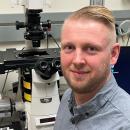NBDF funds a broad range of research programs that seek to increase our understanding of the science behind bleeding disorders, how they affect people's lives, and pathways to better treatments and cures.

Elucidating the Innate Immune Response to Factor IX through a Hemophilia B Mouse Model
Dr. Chau obtained her Bachelor of Science in Biomolecular Engineering from Santa Clara University in 2019 and her Ph.D. in Integrative Pathobiology from the University of California, Davis in 2024. Currently, she is a postdoctoral researcher at the Stanford School of Medicine, working under the mentorship of Dr. Glaivy Batsuli. Her research focuses on elucidating the innate immune response to factor IX (FIX) utilizing her expertise in bioinformatics to bridge gaps in the understanding of immune tolerance and reduce antigenicity in hemophilia B treatments.
Individuals with hemophilia B are susceptible to spontaneous and injury-induced bleeding events throughout their lives. Early diagnosis and initiation of factor IX (FIX) replacement therapy in individuals with a severe bleeding phenotype is critical for bleed prevention, managing bleeding episodes, and preventing the long-term occurrence of frequent bleeds. Roughly 3-10% of individuals with hemophilia B develop inhibitors that limit the hemostatic efficacy of FIX replacement and increases the risk of uncontrolled bleeding. In contrast to factor VIII (FVIII) inhibitor development in hemophilia A, individuals with hemophilia B and inhibitors have limited treatment options for inhibitor eradication due to the risk of hypersensitivity reactions, anaphylaxis, and nephrotic syndrome with FIX re-exposure. Despite extensive research into the immune response against FVIII, an in-depth understanding of mechanisms that define the immune response to FIX is lacking. Our research project aims to investigate the innate immune response pathway underlying the onset of FIX inhibitors. This project focuses on two aims: (1) defining the role of dendritic cell (DC) subsets in FIX inhibitor development and (2) identifying the cytokine signature, specifically IL-13, in this process. Expected outcomes of our study will contribute towards understanding FIX inhibitor development and potential therapeutic interventions.

The Role of Tissue Factor in Blood Coagulation Activation and Bleeding risk in Mice and Humans
Dr. Brake has a background in genetics, molecular biology, and biochemistry, with research experience spanning thrombosis genetics, publications in PNAS and JCI, and multiple academic awards. Currently a postdoctoral fellow at Beth Israel Deaconess Medical Center, Dr. Brake investigates the genetic regulation of tissue factor (F3) in hemostasis and cancer-associated thrombosis, while collaborating with the BioMe Biobank and aiming to eventually lead their own research lab.
This project is the first to study humans with a genetic deficiency in tissue factor, which activates the first step in the formation of blood clots. The goal is to understand how this deficiency changes the baseline amounts of byproducts produced from the blood clotting pathway, and whether these individuals have an increased risk of bleeding.

Structural Investigation of Activated Factor VIII and the Intrinsic Tenase Complex by Single-Particle CryoEM
I received by BS in Biochemistry from the University of Arizona in 2012. I then received my PhD at the University of Maryland, Baltimore County while studying under Dr. Elsa D. Garcin. I am currently a postdoctoral scholar at Western Washington University under Dr. P. Clint Spiegel. Our research focuses on the structure/function of activated coagulation factor VIII and factor IX and how the two proteins bind to lipid membranes to form the intrinsic tenase complex. The results from this research will elucidate the mechanism behind hemophilia A/B-associated missense mutations and how factor replacement therapeutics can be rationally designed for increased pharmacokinetic properties.

Mapping inter-domain interactions in VWF with new type 2B von Willebrand disease mutations
Dr. Qian Liang received the MBBS degree in 2010 from Sichuan University and the M.S. degree in 2013 from Shanghai Jiaotong University in China. Dr. Liang worked as a Research Fellow in the Department of Laboratory Medicine in Shanghai Ruijin Hospital, which is a Heamophilia Treatment Centre for hard-to-treat patients in the Southeastern region of China. She received her Ph.D. degree in Laboratory Medicine in 2022, and is currently a visiting postdoctoral fellow in Professor Renhao Li’s lab in the Aflac Cancer and Blood Disorder Center, Department of Pediatrics at Emory University School of Medicine. Her research work focuses on the structure and function of von Willebrand factor, as well as the development of related diagnostics and therapeutics, and she has published 6 research papers.

Neutrophil Extracellular Traps Promote Joint Injury in Hemophilia
Tomasz received his Pharm.D. degree in 2019 in Pharmacology and Toxicology science from Medical University of Bialystok, Poland, and immediately started his postdoctoral appointment at Vascular Medicine Institute at the University of Pittsburgh, PA. Tomasz's research focuses on the innate immune mechanisms in platelets and neutrophils as well as thrombo-inflammation pathophysiology. He uses cutting-edge intravital microscopy techniques to image in real-time the interplay between neutrophils and platelets during the initial stages of immune system activation. His work has authentic interdisciplinary nature since he studies cross-talk between innate immune signaling in neutrophils, Factor VIII deficiency, liver diseases and macroscale proteomics and genomic profiles of neutrophils and platelets under inflammatory stress. Until now, he proved that neutrophil activation seems to be a key player in the hemophilic arthropathy progression, dedifferentiated sinusoidal endothelium impacts liver-directed gene transfer in Hemophilia-a mice, and that liver to lung microemboli NETs promote Gasdermin-D-dependent inflammatory lung injury in Sickle Cell Disease. Tomasz has been appreciated with multiple awards from national and international societies and institutions as well as his research activities were supported by numerous extramural funding sources. In his scientific and personal life, he proudly follows the University of Pittsburgh's motto - Veritas et Virtus.

Rescue of FVIII mutant expression by translational and post-translational modulation using small molecule therapy
Vishal Srivastava is working as a postdoctoral fellow in Dr. Bin Zhang’s lab at the Genomic Medicine Institute, Lerner Research Institute, Cleveland Clinic. He received his Ph.D. from the CSIR-Central Drug Research Institute/Jawaharlal Nehru University, India. As a recipient of the JGP Fellowship, he will study the role of proteostasis regulators/chaperone-like small molecules and ribosomal readthrough compounds to correct protein impairments due to missense and nonsense mutations in hemophilia A (HA) patients. He hopes to develop innovative therapeutic approaches for treatment of HA patients based on their mutations.

Roles of the B domain in regulating the synthesis and secretion of FVIII Year 2021-2023
Dr. Yuan Zhang obtained her Ph.D in microbiology from Wuhan University, China, in 2015. Her Ph.D work focused on creating new or more effective genetically engineered vaccines against human viruses. In 2016, she joined Dr. Bin Zhang’s group as a postdoctoral fellow at the Lerner Research Institute, Cleveland Clinic. She works on understanding the mechanism of receptor-mediated ER-Golgi transport of secreted glycoproteins. In her JGP project, she aims to identify B domain signals that direct FVIII into the LMAN1-MCFD2 secretory pathway, and investigate the importance of the B domain in FVIII biosynthesis and LMAN1-MCFD2 mediated secretion in mouse models. She hopes that her research will provide important information for guiding recombinant FVIII production and the design of hemophilia A gene therapies.

Antibody-mediated FV/FVa resistance as a therapeutic approach for hemophilia
Dr. Sean Quinn is a postdoctoral fellow at the Children’s Hospital of Philadelphia in the laboratory of Dr. Rodney Camire. Dr. Quinn received his doctoral degree in Biochemistry/Biophysics from Rensselaer Polytechnic Institute in 2019. For his JGP project, Dr. Quinn will develop novel monoclonal antibodies (mAbs) that bind and protect FV or activated FV (FVa) to promote coagulation in the context of hemophilia. To accomplish this goal, Dr. Quinn will use biochemical and biophysical approaches to map the epitopes where lead candidate mAbs bind to FV/FVa. Moreover, he plans to assess the efficacy of these mAbs using a combination of in vivo approaches with an already established hemophilia mouse model. Long-term, Dr. Quinn’s goal is to become an independent investigator to develop approaches to modulate anticoagulant pathways to treat bleeding.

The role of EPCR-FVIIa in the pathogenesis and treatment of hemophilic arthropathy
From University of Texas Health Science Center at Tyler (UTHSCT). Dr. Magisetty completed Ph.D. doctoral training on the evaluation of FVIIa-EPCR interactions in the management of hemophilic arthropathy and is enthusiastic looking forward to the postdoctoral training on the “Role of EPCR-FVIIa anti-inflammatory signaling in the pathogenesis and treatment of hemophilic arthropathy”.

The role of FVIIa-released endothelial extracellular vesicles in hemophilia therapy
I am currently working as a Postdoctoral Research Associate at the University of Texas Health Science Center at Tyler, Tyler, Texas, under the mentorship of Professor L. Vijaya Mohan Rao. My research focuses on elucidating novel mechanisms by which FVIIa provides hemostatic and anti-inflammatory effects and the relevance of these mechanisms in treating bleeding disorders and hemophilic arthropathy. I graduated from the University of Calcutta, India, in 2009 with a bachelor’s degree in Microbiology. My post-graduation was also in Microbiology from India in 2011. I completed my doctoral studies in 2019 from the Indian Association for the Cultivation of Science, India, where I focused on understanding the mechanistic details of tissue factor-factor VIIa-induced progression of human breast cancer. I published several peer-reviewed articles from my Ph.D. thesis work in journals, such as Journal of Biological Chemistry, Cellular Signaling, and Molecular Carcinogenesis. I enjoy playing video games, reading novels, and cooking various Indian foods.

Increasing the efficacy of prophylactic infused FIX in hemophilia B patients by manipulating its binding to collagen IV
Dr. Xuejie Chen is a postdoctoral fellow in the laboratory of Dr. Darrel Stafford at the University of North Carolina at Chapel Hill. Before joining Dr. Stafford’s lab, she received her Ph.D. degree in Cell Biology from Beijing Normal University, P. R. China. In her JGP Fellowship project, Dr. Chen aims to study the contributions of extravascular factor IX (FIX) to blood coagulation and to search for FIX variants that could efficiently displace the endogenous dysfunctional FIX in hemophilia B patients. To achieve this goal, Dr. Chen will study the binding between FIX and the subendothelial basement membranes, mainly type IV collagen, and use the site-directed random mutagenesis library to screen for tighter binding FIX molecules. In doing so, she hopes to identify a FIX variant that can be used in hemophilia B patients for better coagulation therapies.

Preclinical Development of Nuclease-Free Gene Editing for Lifeling Treatment of Bleeding Disorders

Identification of a Potential Novel Role for Factor IX Using a Zebrafish Model

The Epitopes Recognized in the Early Immunue Response to Factor VIII

Protein Engineering of Plasminogen Activator 1 to Develop Novel Regulators of the Fibrinolytic and Hemostatic Pathways
Dr. Laura Haynes received her PhD in biochemistry from the University of Vermont where she studied how flow conditions throughout the vasculature affect thrombin generation, as well as the role of the platelet membrane in modulating the structure/function of the platelet associated prothrombinase complex. Dr. Haynes is currently a research fellow with Dr. David Ginsburg at the University of Michigan. During her JGP fellowship, she will use phage-display technology coupled with high throughput DNA sequencing to make an exhaustive index of the mutations in plasminogen activator inhibitor-1 (PAI-1) that prolong its half-life while not being deleterious in the inhibition of its canonical targets urokinase-type plasminogen activator (uPA) and tissue-type plasminogen activator (tPA). In doing so, she hopes to identify a PAI-1 variant that can downregulate the fibrinolytic process. Dr. Haynes will also implement similar technology to engineer a PAI-1 variant that inhibits activated protein C (APC), thereby prolonging thrombin generation. She hopes that this research will lead to potential therapeutic agents to treat hemophilia and other bleeding disorders.
Identifying novel hemostatic regulation through species-specific studies using zebrafish
Dr. Kari Lavik is a postdoctoral fellow at the University of Michigan in the laboratory of Dr. Jordan Shavit. She received a B.A. in biology from Case Western Reserve University, and her Ph.D. in Biomedical Sciences from The University of Toledo. Her graduate work focused on the study of cancer motility and metastasis through which she became interested in using zebrafish as a model for human disease. In February of 2017, Dr. Lavik joined the Shavit Laboratory in the Department of Pediatrics at the University of Michigan to use zebrafish for the study of bleeding and clotting disorders. For her 2018 JGP fellowship project, she will model hemophilia in the zebrafish, looking for novel species-specific regulators of hemostasis. By delving deeper into the genetic mechanisms that underlie the intrinsic pathway in zebrafish, Dr. Lavik will look for novel gene interactions that can be therapeutically targeted in patients with hemophilia.

Identification, Characterization and Therapeutic Targeting of Key Molecular Markers and Pathways Implicated in the Development of Hemophilic Arthropathy
Dr. Esther Cooke received her Ph.D. from the Leeds Institute of Cardiovascular and Metabolic Medicine at the University of Leeds, U.K., where she studied the role of fibrinogen phosphorylation in thrombosis. Dr. Cooke is currently a postdoctoral fellow in the laboratory of Dr. Annette von Drygalski, at the University of California San Diego, and in collaboration with the laboratory of Dr. Laurent Mosnier at the Scripps Research Institute. Dr. Cook's JGP Fellowship project will focus on pathological mechanisms associated with joint bleeding, re-bleeding, and the development of hemophilic arthropathy. Dr. Cooke will perform comprehensive gene expression analyses to explore key molecular markers and pathways that drive soft tissue inflammation and vascular changes in joints after bleeding. In this way, she hopes to identify new therapeutic targets and develop novel treatment strategies to down-regulate these processes, thereby reducing re-bleeding tendency and slowing the progression of hemophilic arthropathy.

Development of Hematopoietic CRISPR/Cas9 Gene Activation for Hemophilia Therapy
Dr. Satish Nandakumar is currently a postdoctoral fellow in the laboratory of Dr. Vijay Sankaran at the Boston Children's Hospital. Previously, he did his graduate work at the St. Jude's Children's Research Hospital in Memphis, Tennessee. In his JGP Fellowship project, Dr. Nandakumar aims to develop a novel gene therapy approach for hemophilia that involves activation of the endogenous factor VIII or IX genes within hematopoietic stem cells by taking advantage of the CRISPR/Cas9 gene activation system. This work has the potential to benefit patients with mild hemophilia mutations.

Dissecting the Roles of Non-muscle Myosin IIA in May-Hegglin Platelet Disorders

Mechanisms and Therapeutic Strategies Targeting TAFI-mediated Vascular Remodeling in Hemophilic Arthropathy
Dr. Tine Wyseure obtained her Master’s degree in Drug Discovery and Development, and earned her Ph.D. in Pharmaceutical Sciences at the University of Leuven, Belgium. Since 2015, she has been a research associate in the lab of Dr. Laurent Mosnier at The Scripps Research Institute in San Diego. Dr. Wyseure’s 2016 JGP research fellowship award project is focused on investigating the effects of impaired TAFI activation in hemophilia on the progression of hemophilic joint disease. The lack of active TAFI worsens joint bleeding and chronic inflammation and drives the striking development of fragile blood vessels in diseased joints. In search of the missing link, Dr. Wyseure has discovered a novel paradigm on how the formation of new blood vessels is controlled by TAFI and suggests that patients with hemophilia may lack this control switch, causing the formation of unstable and leaky blood vessels.

